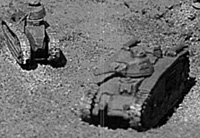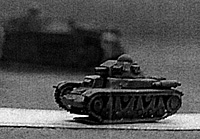 Whenever historical miniatures enthusiasts discuss or play the Blitzkrieg period
of World War II, the topic of how the French Army performed in 1940 comes up.
Whenever historical miniatures enthusiasts discuss or play the Blitzkrieg period
of World War II, the topic of how the French Army performed in 1940 comes up.
French FT-17 tank (left) and Char BI (right)
Many people show disdain or simply dismiss the French Army's performance. This is justified in the sense that in 1939, France was considered to have the world's best standing army and it was totally defeated in 6 weeks.
However, what the vast majority of the people don't know is that the French Army won the first large scale tank battle that took place up to that point in the war using French tanks, French troops and French tactics! It occurred near the Belgian town of Gembloux. Before we proceed ftu-ther in regards to this battle, we need to examine some reasons as to why the French Army performed the way it did.
World War I was devastating to France as a country. It is safe to say that France literally lost a generation of young men on the battlefields. Because of this, the postwar philosophy of the generals changed from being on the offensive to being on the defensive. Ohe of the results was the development of the Maginot Line. It was a series of defensive fortifications constructed during the 1920's and 1930's along a portion of the French border. Unfortunately, the line did not extend all the way to the English Channel.
As a result, in 1940, the Germans simply bypassed this defensive line. Another consequence of World War I was that when France needed to mobilize its troops in 1939, there simply were not enough men to fill all the necessary positions in the French Armed Forces. In addition, the French political climate in the 1920's and 1930's was one of incessant turmoil and change. This dreary political climate did not serve to boost the morale of the average French soldier. Now while these things had their effects, there were still other factors involved.
The French military establishment was not modernized enough to deal with the blitzkrieg style of warfare. The concept of using tanks as a massive group as opposed to just being used as infantry support was embraced by the German High Command, but not so much in the French High Command. Now it must be said that there were French officers who saw the potential in using massed armor as a functioning unit (DeGaulle was one of them), but they were largely ignored much to the French High Command's regret. Airpower was another facet that the French largely ignored despite seeing its uses in the Spanish Civil War. Naturally, the Germans learned many things about combined arms because of the Spanish Civil War. Still another problem that the French Army had was a lack of radios. Most of the French Army headquarters had to communicate with each other by carrier pigeon! Yet the French had two advantages over the Germans. They had more tanks than the Germans did, although most of those tanks were of World War One vintage FT- 17s and the like.
 French Hotchkiss tank
French Hotchkiss tank
The other advantage was that the newer French tanks had thicker armor (like the Somua and the Char-B) that did offer better protection but this advantage was somewhat offset from the cramped one man turret that all the French tanks had. This made things more difficult for the tank commander who had to act as commander, gunner and loader!
Now that we have looked at the factors affecting the French Army in 1940, we need to look at what happened at the Gembloux Gap. On May 10, 1940, the Germans launched their offensive in the West. The French First Army was ordered to take up a position along a line running through Wavre-Emage-Gembloux and Naux. This was a 75 mile forced march and they needed time to get into their defensive positions. The task of delaying the German advance was given to General Prioux and his Cavalry Corps which was made up of the 2nd and 3rd Division Legere Mechanique (Light Mechanized Division). These divisions were equipped with the Somua-S35 and Hotchkiss-35 tanks.
On the 11th they were ordered to advance beyond the Dyle River Line. The Dyle River Line was the proposed first line of defense for the Allies should the Germans ever attack. When Prioux's men got to the Dyle River Line, there were no fortifications or preparations of any sort in the area! Prioux telephoned the commander of the 1st French Army with the alarming news and asked that he could pull back to the other defense line behind the Scheldt River. Permission was granted, but it was too late as the fast-moving German columns were advancing seemingly everywhere. Contact with the enemy was inevitable.
On May 11, recon elements of the 2nd DLM encountered the advance elements of the 4th panzer Division near Oreye. The French commander was fairly aggressive and temporarily halted the German advance by engaging his Panhard armored cars with the German Mark IIs. This action bought time for some Belgian units to pull back to safety that would otherwise be outflanked in addition to buying time for other French units to deploy. At this point, the Germans were still 50 kilometers from Gembloux. May 12th would bring a number of engagements in the area.
The German Stukas were brought in to soften up the French positions. Near the town of Crehen, the 2nd Cavalry and 11th Dragoons of the 3rd DLM engaged elements of the 35th Panzer Regiment which was part of the 4th Panzer Division. Even though the French commander died early in the battle, the French gave as good as they got. Both sides suffered heavy casualties before the French had to pull back because the Germans did a flanking move and there were not enough French troops to deal with it.
On the same day, near the town of Hannut, 31 kilometers Northeast of Gembloux, elements of the lst Cavalry of the 3rd DLM engaged the 35th Panzer Regiment from prepared positions. French leadership had shone that day as the Hotchkiss-35 tanks maneuvered from cover to cover firing on the Germans at the same time.
Losses on both sides were heavy, but on that day, the French did stop the Germans from achieving their objective. Unfortunately for the French, the Germans were able to recover many of their panzers from the field and repair them for future battles.
Thisnes
Another encounter took place near the town of Thisnes which is about 10 kilometers to the Northwest of Hannut. There, elements of the 4th Panzer Division with some supporting infantry attacked headlong into the town. There, French infantry from the 3rd DLM along with a group of antitank guns made a desperate stand. When the German commander went back toward the German rear to get more infantry some Sornua tanks of the 5th Light Mechanized Brigade counterattacked. French and German tanks were stalking each other in the streets as darkness was falling. Both sides broke off contact and pulled back to friendly lines.
Up to this point, the 2nd DLM had seen little combat, but that would soon change. Talk aboui letting no good deed go unpunished! The commander of the 2nd DLM sent a group of Sornua tanks to help out the beleaguered 3rd DLM. Near the town of Crehen this group would ran into a mixed German unit consisting of antitank guns and a few light tanks. This group was covering the flank of the advancing 4th Panzer Division.
From the start, things went wrong for the French. The casualties were high as the Sornua tanks never did reach their destination. The 2nd DLM had used up its reserve and found itself under attack. More combat took place that day as the French troops fought house to house in villages like Jauche and Jandrain. By the 14th, the 2nd and 3rd DLM had to fall back behind Gembloux to regroup and reorganize. They had held up the 3rd and 4th Panzer Divisions long enough for the 1 st Moroccan Division and the 15th DLM to take up positions across the Gembloux Gap. If the Germans thought that the French DLM were difficult to deal with, the Moroccans were an even tougher nut to crack. near the town of Emage which is a few kilometers to the Northwest of Gembloux the Moroccans held out repeatedly against the Germans throughout most of the day taking cover behind the railroad tracks that run along Emage and Gembloux.
The Germans, after using a large quantity of infantry and Stuka support finally took the town on the morning of the 15th. A violent Moroccan counterattack prevented the Gen-nans from advancing farther that day.
The fighting was even more violent as both sides fought hand to hand for the Chemin Creux (Hollow Road) that was just east of the railroad tracks. The 2nd Company commander, Capt. Grudler, phoned battalion headquarters after having suffered 75% casualties as to whether he should continue to hold. The answer came: Hold until relieved. Four hours later, the French counterattack regained lost ground, but relief came too late for Capt. Grudler and his remaining men. They denied the road to the Germans to the very end. However, despite holding Hoepner's Panzers at bay for 72 hours, the Germans broke through at the Meuse River and broke out of Sedan. The French flanks were collapsing rapidly. The French and the Moroccan soldiers could not believe that they had been given the order to retreat.
In conclusion, did the Battle at Gembloux affect the outcome for France? As history shows, it did not. It was a victory that was and could not have been taken advantage of However, the fact remains, that elements of the French army, did hold the German panzer units at bay, even for a short while. This is in spite of the vaunted German blitzkrieg tactics. Hopefully, this article has shed a new light on some of the French units that fought in May 1940.
Back to Table of Contents The Messenger August 2002
Back to The Messenger List of Issues
Back to MagWeb Magazine List
© Copyright 2002 by HMGS/PSW.
This article appears in MagWeb (Magazine Web) on the Internet World Wide Web.
Other military history articles and gaming articles are available at http://www.magweb.com